How to Use Delay Pedals Effectively: A Complete Guide
Category: Guitar Gear
Mastering Delay Pedals: Elevate Your Guitar Tone and Style
If you're a guitar enthusiast eager to add depth, space, and creativity to your sound, learning how to use delay pedals effectively is a game changer. Whether you're a beginner or an intermediate player, you’ve likely encountered delay effects but might struggle with dialing them in just right or understanding their full potential. You might have landed on this post searching for practical, actionable advice—beyond basic definitions—to enhance your playing and production workflow. Maybe you want to craft ambient soundscapes, tighten rhythmic grooves, or simply add texture without muddying your tone.
This guide cuts through the noise by focusing on how delay pedals work in real-world contexts, how to adjust settings to suit different musical styles, and how to integrate them with your existing gear. We go step-by-step into key concepts like delay time, feedback, mix, modulation, and tap tempo, along with tips on common pedal types—from analog to digital and multi-delay units. Inside, you’ll find insights not only on sound design but also practical applications for live and studio scenarios.
If you’re serious about transforming your guitar effect setup and mastering delay pedals, this post is tailored for you. By the end, you'll understand how to create lush echoes, rhythmic repeats, and subtle backdrops that make your playing stand out. So plug in, read on, and unlock the true potential of delay effects in your music!
- Mastering Delay Pedals: Elevate Your Guitar Tone and Style
- Understanding What a Delay Pedal Does: Types and Basic Concepts
- Key Delay Pedal Controls Explained: Delay Time, Feedback, and Mix
- Exploring Common Delay Styles: Slapback, Ping Pong, and Modulated Delays
- Using Tap Tempo and Syncing Delays to Your Playing
- Creative Techniques: Layering Multiple Delays and Combining Effects
- Optimizing Your Signal Chain: Where to Place the Delay Pedal
- Delay Pedals in Different Musical Contexts: From Blues to Ambient to Rock
- Recording and Production Tips: Capturing Delay Effects Cleanly in the Studio
- Troubleshooting Common Issues: Avoiding Muddy Repeats and Managing Noise
- Budget to Boutique: Recommended Delay Pedals for Every Player Level
Understanding What a Delay Pedal Does: Types and Basic Concepts
At its core, a delay pedal captures your guitar signal and plays it back after a brief period, creating an echo effect that can range from subtle to dramatic. This simple concept opens a vast sonic palette, allowing guitarists to add depth, space, and rhythmic complexity to their sound. The three fundamental parameters that shape a delay pedal’s character are delay time, feedback (repeats), and mix level.
- Delay Time determines the interval between the original note and the echoed repeat, measured in milliseconds (ms). Short delays (around 50-150 ms) create a slapback effect often used in rockabilly, while longer times produce cascading echoes and ambient textures.
- Feedback (Repeats) controls how many times the delayed signal is repeated. A low feedback setting gives a single or few echoes, whereas higher feedback can generate endless delay loops for ethereal soundscapes.
- Mix Level (also called blend or wet/dry) adjusts the balance between your dry, unaffected guitar signal and the delayed repeats. A subtle mix adds spaciousness without overpowering the original tone, while a high mix can turn delay into a dominant effect.
Types of Delay Pedals
Knowing the type of delay pedal you’re working with is key to dialing in tones that fit your style:
-
Analog Delay
Utilizes bucket-brigade devices (BBDs) to create warm, natural-sounding repeats with a characteristic slight degradation and modulation as the signal passes through the circuitry. Analog delays typically have shorter maximum delay times (up to ~300 ms) but excel at adding vintage character and smooth repeats that sit nicely in the mix. -
Digital Delay
Offers pristine, crystal-clear repeats and often features longer delay times, sometimes up to several seconds. Digital units can emulate other delay types, include modulation effects inside the delay repeats, and provide versatile presets. Their transparent sound is ideal for modern and ambient playing styles that require clarity and precision. -
Tape Delay
Inspired by vintage tape echo machines, tape delays introduce distinctive warmth, slight pitch modulation (wow and flutter), and natural degradation with feedback. These pedals emulate the organic imperfections of physical tape loops, adding unique texture and a nostalgic vibe to any guitar tone.
By understanding these basic delay concepts and pedal types, you can better tailor your settings to a desired tonal outcome—whether it’s a subtle thickening of your sound or a sprawling sonic landscape. Mastery of delay parameters in conjunction with pedal type empowers you to craft your signature echo effects with confidence and creativity.

Image courtesy of Alexey Demidov
Key Delay Pedal Controls Explained: Delay Time, Feedback, and Mix
To harness the full creative potential of your delay pedal, it’s essential to understand the three primary controls that shape its sound: Delay Time, Feedback, and Mix. Mastering these knobs will allow you to sculpt your echoes precisely—whether you’re aiming for tight rhythmic repeats, lush atmospheres, or subtle texture enhancements.
1. Delay Time: Setting the Musical Echo Interval
Delay Time controls the gap between your original guitar signal and the repeated echo, measured in milliseconds (ms). Adjusting delay time is crucial because it directly influences how the echo interacts rhythmically and tonally with your playing.
- Short Delay Times (50–150 ms): Ideal for slapback effects commonly heard in rockabilly and country. This setting adds a quick bounce without cluttering the sound.
- Medium Delay Times (150–400 ms): Great for creating rhythmic echoes that interplay with your strumming or picking patterns, perfect for blues, pop, and classic rock.
- Long Delay Times (400 ms and above): Used for ambient, spacious sounds and sonic textures. Longer delays work well for atmospheric genres like shoegaze, post-rock, and experimental music.
When tweaking delay time live, use your ear to lock the repeats rhythmically in sync with the tempo of the song. Many digital delay pedals feature tap tempo functionality to assist with this, enabling quick real-time adjustments.
2. Feedback: Controlling Echo Density and Sustain
The Feedback knob determines the number of repeats your delay pedal produces by feeding the delayed signal back into itself. This control influences the intensity and decay of your echoes.
- Low Feedback Settings: Yield a few distinct repeats before fading out, adding subtle depth without overwhelming the original tone.
- High Feedback Settings: Create dense, cascading layers of repeats that can build into an evolving soundscape or even self-oscillate into an infinite loop for experimental effects.
In live settings, use moderate feedback for rhythmic clarity and avoid excessive repeats to prevent muddiness. In studio production, however, pushing feedback higher can generate creative pads or atmospheric backgrounds when blended tastefully with other instruments.
3. Mix (Blend): Balancing Dry and Wet Signals
The Mix control (sometimes labeled blend or wet/dry) balances your clean guitar tone ("dry") and the delayed repeats ("wet"). This parameter dramatically impacts how prominent the delay effect sits in the overall sound.
- Low Mix Levels: Delay softly enhances your tone, adding space and subtle rhythmic interest without drawing too much attention.
- Medium Mix Levels: The echoes become clearly audible, thickening your guitar sound and creating a sense of depth.
- High Mix Levels: Delay dominates the output, which is excellent for ambient washes or lead lines drenched in echo.
Adjust your mix setting according to the musical context: lower mixes suit busy band arrangements or when playing rhythm guitar, while higher mixes complement solo passages or atmospheric sound design.
Practical Tips for Tweaking Delay Controls Live and in the Studio:
- Start with moderate settings: Begin with a delay time that matches the song tempo, feedback around 30-40%, and mix near 20-30%. Fine-tune from there based on the style and feel.
- Use tap tempo for tight rhythmic synchronization: Tap tempo keeps delay time locked to the song's beat, invaluable for live performance.
- Beware of feedback runaway: Avoid cranking feedback too high in live situations unless you want controlled feedback loops; it can quickly overwhelm your sound.
- Pair delay with reverb: Combining delay with reverb can add natural dimension—use this in the studio to create lush, expansive soundscapes.
- Adjust mix according to the mix: When playing with a full band or recording multiple tracks, dial delay mix lower for clarity, and boost it during solos or ambient passages.
Understanding how delay time, feedback, and mix interact will empower you to dial in delay sounds perfectly suited for your playing style and musical environment. Experiment with these controls to discover unique echo textures that complement your guitar tone and enhance your overall sonic palette.
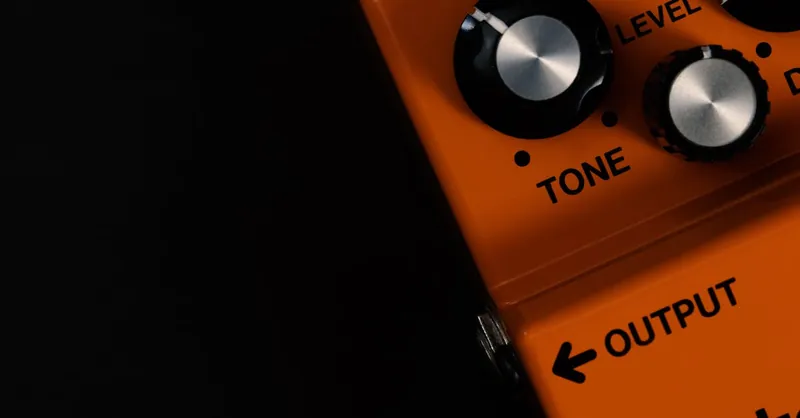
Image courtesy of E
Exploring Common Delay Styles: Slapback, Ping Pong, and Modulated Delays
Delay pedals are incredibly versatile, and one of the best ways to harness their power is by experimenting with popular delay styles that have defined countless iconic guitar tones. Understanding the sonic characteristics and typical applications of these styles will help you integrate delay effects that enhance your playing across genres.
1. Slapback Delay: Tight, Percussive Echo with Vintage Flair
Slapback delay is characterized by a very short delay time, typically between 70 to 150 milliseconds, producing a single, quick repeat that adds a sense of space and rhythmic bounce without cluttering your sound. This style is synonymous with rockabilly, country, and classic rock tones, famously used by guitarists like Scotty Moore and Elvis Presley’s early sessions.
Key Characteristics:
- Ultra-short delay time (70-150 ms)
- Usually one or two repeats with low feedback
- Mix set high enough to be noticeable but not overpowering
- Creates a "doubling" effect, enhancing rhythm and attack
Genres & Examples:
- Rockabilly: Carl Perkins’ "Blue Suede Shoes"
- Classic Country: Johnny Cash’s guitar riffs
- Early Rock ’n’ Roll: Elvis Presley’s rhythm guitar parts
Slapback delay works best as a subtle rhythmic enhancer, perfect for cutting through a mix with clarity and snap.
2. Ping Pong Delay: Stereo Width and Dynamic Movement
Ping pong delay bounces the delayed signal between the left and right stereo channels, creating an immersive spatial effect and a dynamic sense of movement in your guitar sound. This style shines in genres that benefit from rich stereo imaging such as funk, pop, modern rock, and electronic influences.
Key Characteristics:
- Alternates echoes between stereo outputs (L↔R)
- Often uses moderate delay times (200-400 ms)
- Adds width and a swirling sense of space
- Enhances rhythmic complexity and groove
Genres & Examples:
- Funk & R&B: Nile Rodgers’ Chic-style rhythmic comping
- Pop & Indie Rock: U2’s The Edge on tracks like “Where the Streets Have No Name”
- Modern Alternative: Bands layering textured guitar parts
When paired with a digital or multi-delay pedal, ping pong delays create lush stereo landscapes that make your guitar fill the mix with vibrant energy.
3. Modulated Delay: Rich Textures with Movement and Warmth
Modulated delay introduces subtle variation in pitch or timing to the repeated echoes by combining delay with a modulation waveform (chorus, vibrato, or flanger). This adds dimension, warmth, and a shimmering quality to your delays, perfect for ambient, shoegaze, and psychedelic styles.
Key Characteristics:
- Delay repeats are "warbled" or detuned with modulation
- Creates a smooth, swirling echo texture
- Often features slower delay times (300 ms and above)
- Adds lushness without muddying the mix
Genres & Examples:
- Shoegaze & Dream Pop: My Bloody Valentine’s ethereal guitar layers
- Psychedelic Rock: David Gilmour’s “Echoes” and “Shine On You Crazy Diamond”
- Ambient Music: Post-rock bands like Explosions in the Sky
Modulated delays elevate simple repeats into evolving soundscapes, making them ideal for atmospheric guitar parts that require emotional depth and complexity.
By experimenting with slapback, ping pong, and modulated delay styles, guitarists can unlock a wide range of expressive possibilities that suit different musical contexts. Whether you want crisp, rhythmic clarity or sweeping, immersive textures, mastering these popular delay effects will greatly expand your tonal arsenal and enhance your creative output.

Image courtesy of Alexey Demidov
Using Tap Tempo and Syncing Delays to Your Playing
One of the most powerful features on modern delay pedals is tap tempo, which allows you to manually set the delay time in real-time by tapping a footswitch or button in sync with the song’s tempo. This eliminates guesswork when dialing in the perfect rhythmic delay and ensures your echoes lock tightly with your playing, making delay effects feel more natural and musical. By tapping along to the beat, you can quickly match delay repeats to the groove of a live performance or rehearsed track without breaking your flow.
Why Tap Tempo Matters for Guitarists
- Instant tempo matching: Avoid manually fiddling with millisecond settings by tapping the tempo, giving you immediate synchronization with the song’s rhythm.
- Greater rhythmic precision: Ensures that delay repeats complement rather than clutter chords and lead lines, preserving clarity in your tone.
- Versatility across songs: Easily adjust delay times for different tunes or tempo changes within a set, especially useful for gigging musicians.
Syncing Delay Pedals with Drum Machines and DAWs
For players and producers looking to integrate delay effects seamlessly within electronic setups or studio sessions, many delay pedals offer MIDI or clock sync capabilities. Syncing your delay pedal to an external drum machine, sequencer, or Digital Audio Workstation (DAW) allows the delay repeats to automatically follow the session’s tempo, giving you a tightly locked and polished sound.
Key benefits of syncing delays via MIDI or clock signals include:
- Consistent timing across gear: Your delay echoes stay perfectly timed with drum patterns, synth parts, and other sequenced elements.
- Hands-free tempo adjustments: Changing the tempo on your DAW or drum machine updates the delay time instantly on your pedal, streamlining workflow.
- Creative tempo-based effects: Use synced delay times to create rhythmic patterns like triplets or dotted notes by selecting different subdivision settings on your pedal or software.
By mastering tap tempo and learning to sync your delay pedal with external devices, you elevate your guitar tone by integrating delay effects fluidly into any musical context—be it live performance, electronic jam sessions, or studio production. These techniques ensure your delay repeats feel intentional, rhythmically tight, and fully locked into the pulse of the music, transforming delay from a mere effect into a powerful musical tool.

Image courtesy of Kelly
Creative Techniques: Layering Multiple Delays and Combining Effects
To push the sonic boundaries of your guitar tone, layering multiple delay pedals and blending delay with other effects can transform simple echoes into rich, evolving soundscapes. This advanced approach allows you to craft complex textures and dynamic rhythmic patterns that stand out in both live performances and studio productions.
Cascading Delays: Building Depth and Complexity
Cascading delays involve chaining two or more delay pedals with different delay times and settings to create intricate echo patterns. For example, starting with a short slapback delay followed by a longer ambient delay can produce rhythmic depth and expansive spatial effects simultaneously. Key considerations include:
- Setting the first delay with a shorter delay time, lower feedback, and moderate mix to provide a clear initial echo.
- Running that signal into a second delay with longer delay time, higher feedback, or modulated repeats to add ambiance and texture.
- Carefully balancing the mix levels of each pedal to avoid muddying the sound while maximizing dimensionality.
This technique enhances your tone by simulating natural acoustic reflections or creating cascading echo layers that evolve as you play, perfect for ambient post-rock, experimental, and atmospheric styles.
Combining Delay with Reverb and Modulation
Integrating delay pedals with reverb and modulation effects adds lushness and movement to your sound, opening new creative possibilities:
- Delay + Reverb: Using delay before reverb can result in warm, spacious trails that retain rhythmic clarity while enveloping your guitar in shimmering ambience. This combination is ideal for creating cinematic and dream-like guitar tones.
- Delay + Chorus or Phaser: Adding a modulation effect to the delayed repeats introduces subtle pitch and movement variations, enriching the echo texture. This combo works well in psychedelic and shoegaze genres, producing swirling, immersive soundscapes.
- Delay + Tremolo: Applying tremolo after delay adds rhythmic pulsation to your repeats, making your echoes dynamically dance in sync with your playing tempo.
Creating Evolving Soundscapes with Dynamic Control
Beyond static settings, using expression pedals or MIDI controllers to manipulate delay parameters in real-time allows for evolving soundscapes that respond intuitively during live performances or recordings. For instance:
- Gradually increasing feedback or mix via an expression pedal builds tension and intensity.
- Modulating delay time subtly can create natural pitch variations and shifting rhythmic feels.
- Automating delay parameters in a DAW when layering guitars gives controlled movement that breathes life into mixes.
By mastering these layering and combination techniques, you unlock the full creative potential of delay pedals, transforming your guitar tone from straightforward echoes into multi-dimensional sound worlds that captivate listeners and inspire musical exploration.
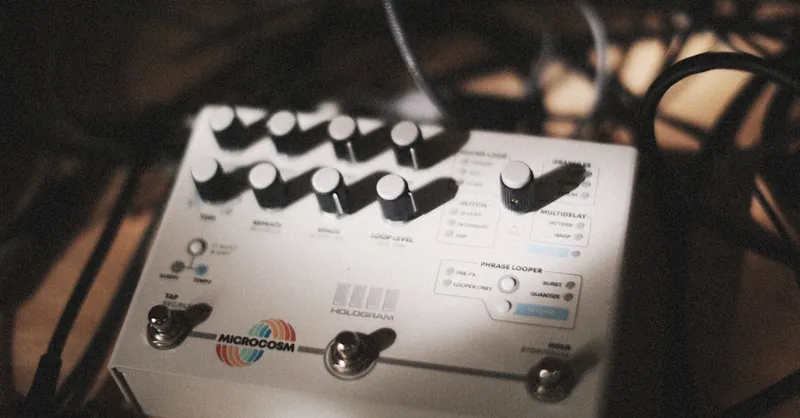
Image courtesy of Alexey Demidov
Optimizing Your Signal Chain: Where to Place the Delay Pedal
The placement of your delay pedal within your pedalboard signal chain dramatically influences your overall tone, clarity, and how your echoes interact with other effects. Understanding where to position delay relative to other pedals—such as overdrive, distortion, modulation, and reverb—can help you preserve the definition of both your dry guitar signal and the delayed repeats. While every rig is unique and experimentation is key, there are some foundational guidelines that will optimize delay’s impact across different setups.
Best Practices for Delay Pedal Placement
-
Delay After Gain Effects (Overdrive, Distortion, Fuzz):
Placing your delay pedal after overdrive and distortion in the chain keeps your repeats clean and distinct. When delay comes before gain pedals, the delayed signals get distorted repeatedly, often resulting in a muddy or uncontrolled sound. By putting delay after gain effects, your pedal repeats retain clarity and preserve rhythmic definition. -
Delay Before Modulation (Chorus, Phaser, Flanger):
Generally, delay pedals work well when positioned before modulation effects. This means the delayed repeats get modulated, which adds interesting movement and texture to the echoes, enriching your soundscape. For instance, delaying a chorus or phaser adds a swirling, evolving quality to the repeats rather than affecting the dry signal exclusively. -
Delay Before or After Reverb – Experiment for Character:
The placement of delay relative to your reverb pedal depends on the sound you want to achieve: - Delay before reverb: Creates echoes that are smoothed and enveloped by the reverb, producing a more natural, ambient effect.
- Delay after reverb: Each echo repeats both the dry signal and the reverb tails, which can lead to a more ethereal, spacey sound but might risk cluttering the mix.
How Delay Position Affects Tone and Clarity
- Early in the chain: Delay placed too early (before distortion or modulation) often triggers unwanted signal degradation and fuzzy repeats, which can reduce note articulation and impact.
- Later in the chain: Positioning delay near the end preserves the tone color and allows delayed echoes to sit naturally in the mix without competing with distortion or modulation textures.
- In stereo setups: Using delay pedals with stereo outputs placed late in your chain can create expansive sound fields, offering rich imaging and separation between your dry and wet signals.
Mastering the optimal positioning of your delay pedal in your pedalboard is as crucial as dialing in its controls. By placing delay after your gain stages and before or after modulation and reverb depending on your style, you maintain tonal clarity and maximize the expressive range of echoes in your rig. Don’t hesitate to experiment within these guidelines to find the sweet spot that complements your guitar tone, playing style, and musical context. This approach ensures your delay effects shine—whether in the studio, on stage, or during creative practice sessions.
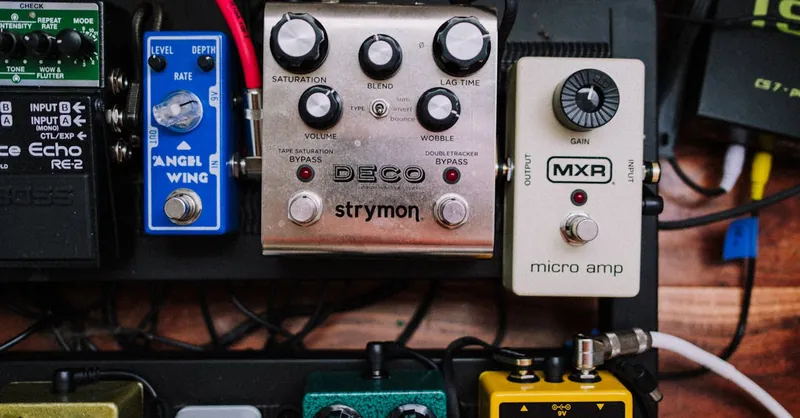
Image courtesy of Kelly
Delay Pedals in Different Musical Contexts: From Blues to Ambient to Rock
Delay pedals are incredibly versatile tools that adapt brilliantly to a wide range of musical genres, enhancing tonal character and adding depth according to each style’s conventions. Understanding how to tailor your delay settings for specific genres—and drawing inspiration from iconic guitarists—can dramatically improve your tonal palette and musical expression.
Using Delay in Blues: Subtlety and Soulful Depth
In blues music, delay pedals are typically used to add warmth and subtle repetition rather than overt effects. Blues guitarists favor short to medium delay times (around 200-350 ms) with low to moderate feedback and mix, creating a natural echo that enriches the phrasing without overpowering the soulful bends and vibrato. This restrained use of delay helps maintain emotional clarity and expressive dynamics.
Famous example: Stevie Ray Vaughan often used delay to add depth to his crisp Texas blues tone, employing a slapback or very subtle repeats to accentuate his solos and rhythm parts without washing out his attack.
Ambient and Shoegaze: Creating Lush Sonic Landscapes
For ambient, shoegaze, and post-rock genres, delay pedals are pushed to their most creative extremes. Here, long delay times coupled with high feedback and mix settings are staples. Modulated or tape-style delay settings add movement and texture, generating sprawling wash effects and evolving soundscapes that form the melodic and harmonic foundation of the music.
Legendary players: Artists like Kevin Shields of My Bloody Valentine and David Gilmour in his ambient sections use delay loops with heavy feedback and modulation to craft immersive, ethereal sound layers that dissolve traditional guitar sounds into rich textures.
Rock and Classic Rock: Adding Rhythmic Drive and Space
In rock-focused styles, delay pedals often emphasize rhythmic interplay and spatial enhancement. Medium delay times synced to the song’s tempo create tight, bouncing repeats that fill out riffs and solos without clutter. The feedback and mix are generally set moderate to keep clarity and punch.
Notable example: The Edge of U2 is synonymous with delay-driven rock tones, using ping pong and tempo-synced delays to build rhythmic momentum and add distinctive stereo depth to his sound, defining many classic rock anthems.
By adapting delay settings—such as delay time, feedback, and mix—to suit the specific vibe and technical demands of your genre, you can exploit the full creative potential of delay pedals. Experimenting with these genre-informed approaches and learning from iconic guitarists will sharpen your ability to craft inspired, style-appropriate delay tones that elevate your playing whether you’re channeling blues, soaring ambient textures, or punchy rock grooves.
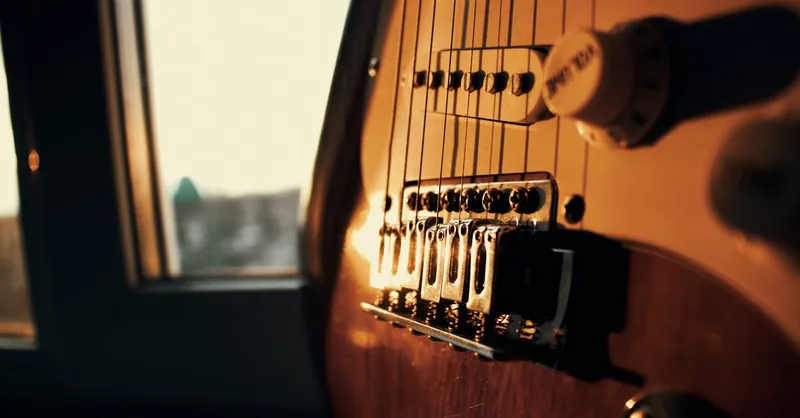
Image courtesy of Ruslan Alekso
Recording and Production Tips: Capturing Delay Effects Cleanly in the Studio
When incorporating delay pedals into your guitar recordings, maintaining clarity and definition of the echoed signals is essential to avoid cluttered or muddy mixes. The key to capturing delay effects cleanly starts from the source and continues through thoughtful mixing techniques. Here are essential considerations to help you preserve the full character of your delay pedal in the studio environment:
Microphone Placement for Amp Capture
- Close Miking and Room Mics: Use a close mic to capture the direct amp sound, which provides the dry guitar tone, while adding a room microphone helps retain the natural ambience and space created by the delay. Blending these signals allows the echoes to sit naturally without overwhelming the core tone.
- Avoiding Phase Issues: When using multiple microphones, carefully check for phase cancellation that can thin out repeats or cause hollow echoes. Experiment with mic distances and angles to preserve the full texture of your delayed signal.
- Capturing Delay Pedal Effects Post-Amp: If your delay pedal runs in the effects loop or inline to the amp, the echoes will be part of the amp’s direct sound. However, if running delay through a line out or DI, capturing both dry and delayed signals separately can increase flexibility during mixing.
Direct Input (DI) and Re-amping
Recording your guitar through a DI box before the delay pedal or amp stage gives maximum control over the delay effect in post-production. This approach allows you to:
- Add delay effects later during mixing using plugins or re-amping hardware pedals, guaranteeing cleaner results and easier automation.
- Record a clean DI track plus delayed layers on separate tracks, which helps prevent delay clutter and enables selective EQ or volume control.
- Experiment with different delay types digitally during mixing if you decide to tweak echo parameters after tracking, ensuring echoes complement the full arrangement.
Mixing Techniques for Delay Clarity
To keep delay repeats clear and musically useful within a full mix, incorporate the following practices:
- Use EQ on Delay Returns: Carve out low-mid frequencies (typically 200-500 Hz) from delay tracks to reduce muddiness without sacrificing warmth. Boosting high frequencies can enhance sparkle and definition on echoes.
- Apply Compression Sparingly: Light compression on delay sends smooths dynamic peaks while avoiding squashing transient repeats, preserving natural echo decay.
- Create Space with Panning and Stereo Imaging: Position delay signals in the stereo field—such as ping pong or wide stereo delays—to prevent masking the dry guitar and other instruments.
- Adjust Delay Mix Levels Contextually: Lower delay mix levels during dense arrangements but increase them for sparse sections or solo parts to maintain impact and clarity.
- Duck Delay with Sidechain Compression: Subtle sidechain compression triggered by the dry guitar signal can temporarily reduce delay volume when you play new notes, preventing echo buildup and preserving note articulation.
Combining precise microphone placement, DI recording, and thoughtful mixing strategies ensures your delay pedal’s unique textures translate faithfully to your recordings. These methods help you retain sonic clarity, prevent mix muddiness, and fully exploit the emotional and rhythmic depth that delay effects bring to your guitar tracks in professional studio production.
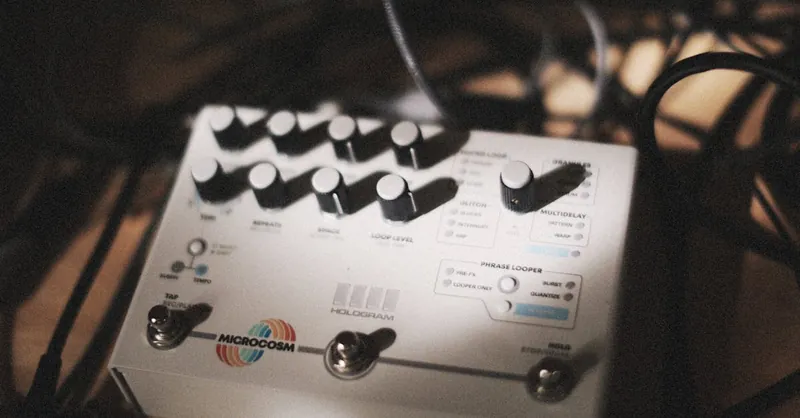
Image courtesy of Alexey Demidov
Troubleshooting Common Issues: Avoiding Muddy Repeats and Managing Noise
Even the best delay pedal settings can sometimes lead to muddiness, feedback runaway, or unwanted noise and latency that obscure your tone and hinder your creative flow. Understanding how to troubleshoot these common delay pedal problems is essential for maintaining clarity and control in your guitar sound, both on stage and in the studio.
Avoiding Muddy Repeats and Delay Clutter
Muddy repeats occur when delayed echoes accumulate density and overlap excessively, causing your guitar tone to lose definition and punch. To prevent this:
- Dial in Moderate Feedback Levels: Excessive feedback sends your repeats into a never-ending loop, which quickly creates noise clutter. Keep feedback at a level where echoes decay naturally, typically below 50-60% on most pedals.
- Adjust Delay Mix Appropriately: High wet mix settings can cause repeated echoes to dominate the output and mask your original playing. Start with a low to moderate mix setting, especially in full-band contexts, and raise it only for solo or atmospheric passages.
- Choose the Right Delay Time: Very long delay times with high feedback can result in overlapping repeats that turn into a wash of sound. Experiment with shorter or tempo-synced delay times to maintain rhythmic clarity.
- Use EQ on Delay Repeats: If your pedal or amp setup allows, apply a gentle EQ cut around muddy low-mid frequencies (200-500 Hz) to keep repeats clear without losing warmth.
Managing Feedback Runaway
Feedback runaway happens when the delayed signal feeds back into itself excessively, causing a self-oscillating effect that can overwhelm your rig. To manage this:
- Turn Down Feedback Immediately: If feedback loops spiral out of control, reduce the feedback knob gradually to stop the runaway.
- Use Volume Control on Delayed Signal: Some pedals offer level or tone controls on the delayed repeats—lowering these can tame feedback-related noise.
- Avoid Stacking Multiple High-Feedback Delays: When cascading delay pedals, keep the feedback moderate on each to prevent compounded runaway effects.
Reducing Unwanted Noise and Latency
Noise issues such as hiss, hum, or latency lag in delay pedals can detract from your tone and responsiveness. To minimize these problems:
- Power Your Pedal Properly: Use a high-quality isolated power supply with the correct voltage and polarity to prevent hum and electrical interference. Avoid daisy-chaining multiple pedals on one adapter when possible.
- Check Cable Quality and Connections: Faulty cables or loose connections can introduce noise and signal degradation. Use shielded instrument cables and periodically inspect jacks and plugs.
- Optimize Delay Buffer Settings: Some delay pedals include a buffer on/off switch—experiment with this setting depending on your pedalboard chain to reduce signal loss and latency.
- Minimize Digital Latency: Digital delays inherently have some latency; reducing the delay time or using analog delay pedals can improve immediacy during live play.
By applying these problem-solving tips for muddy repeats, feedback runaway, and noise control, you can maintain clean, articulate delay effects that enhance rather than detract from your guitar tone. Consistent troubleshooting and mindful pedal adjustments ensure your delay pedal remains a versatile and inspiring tool across all playing situations.

Image courtesy of Alexey Demidov
Budget to Boutique: Recommended Delay Pedals for Every Player Level
Selecting the right delay pedal can be as crucial as mastering its controls, and fortunately, the market offers excellent options for every budget and skill level. Whether you're a beginner hunting for affordability and ease-of-use, or a seasoned professional seeking premium features, reliability, and sonic versatility, choosing the right delay pedal ensures you get the best value and inspirational tones tailored to your needs.
Best Starter Delay Pedals: Affordable and Easy to Use
For beginners, a delay pedal that balances intuitive controls, solid build quality, and essential delay features provides the best starting point. These pedals are perfect for learning delay basics like delay time, feedback, and mix without overwhelming complexity.
Recommended models:
- Boss DD-3T Digital Delay
- Features tap tempo for live tempo syncing
- Clean digital repeats with delay times up to 800 ms
- Robust build and affordable price
-
Ideal for players seeking straightforward, reliable performance
-
TC Electronic Flashback Mini
- Compact size with TonePrint custom presets
- Multiple delay types including analog, tape, and digital
- Simple controls for quick tone dialing
-
Great for pedalboard minimalists or beginners exploring delay varieties
-
MXR Carbon Copy Analog Delay
- Classic warm analog delay sound up to 600 ms
- No-frills three-knob layout (delay, feedback, mix)
- True bypass and modulation switch add tonal flexibility
- A staple for players wanting vintage-style repeats on a budget
Mid-Range Delay Pedals: Expanded Features and Enhanced Sound Quality
Intermediate players often benefit from pedals offering greater control, stereo outputs, and modulation options while maintaining excellent signal integrity and build quality. These models often include features like tap tempo, preset storage, and multiple delay modes suited for diverse playing contexts.
Recommended models:
- Electro-Harmonix Canyon Delay & Looper
- Combines analog, digital, and tape delay emulations
- 10 delay types with modulation and reverse effects
- Built-in looper and tap tempo enhance live versatility
-
Offers creative depth without sacrificing intuitiveness
-
Strymon Dig Dual Delay
- Two simultaneous delay engines for layering complex echoes
- Stereo I/O, extensive modulation, and preset storage
- Pristine digital delay with extensive tweakability
-
Perfect for players ready to explore advanced delay textures and precision
-
Eventide TimeFactor
- Professional-grade digital delay with 10 studio-quality delay types
- Extensive MIDI and expression pedal integration
- Robust rugged design built for gigging musicians
- Used by top-tier guitarists seeking supreme sonic flexibility
Boutique and Professional Delay Pedals: Premium Tone and Cutting-Edge Technology
For professional musicians and tone aficionados, boutique delay pedals offer exquisite craftsmanship, unique circuit designs, and comprehensive feature sets that provide unsurpassed tonal quality and creative control. These units excel in sound character, workflow integration, and durability.
Recommended models:
- Strymon Timeline
- Industry-leading digital delay with 12 fully editable algorithms
- Deep preset management, MIDI sync, and expression control
- Ultra-high fidelity with studio-grade conversion
-
The go-to delay pedal for studio and live professionals demanding top-tier sound
-
Chase Bliss Audio Warden
- Analog delay with DSP-driven modulation and extensive parameter control
- User-friendly preset recall and MIDI support
- Known for warm tone blended with innovative control features
-
Favored by players craving analog character plus digital flexibility
-
Empress Effects Tape Delay
- Faithful tape delay emulation with wow/flutter, saturation, and tape degradation
- Extensive modulation and EQ options shape lush ambient textures
- High-quality components and detailed true bypass switching
- Ideal for musicians wanting authentic tape echo warmth with modern reliability
How to Choose the Right Delay Pedal for Your Level and Style
When investing in a delay pedal, consider these factors to ensure the best fit:
- Feature Needs: Beginners benefit from simple controls; pros may want MIDI, presets, and multiple delay engines.
- Type of Delay: Analog, digital, tape emulations each have distinct sonic characteristics that suit different genres.
- Build Quality: Look for rugged construction and reliability, especially for gigging musicians.
- Budget: Balance desired features with cost; some mid-range pedals offer excellent value for performance.
- Expandability: Consider tap tempo, expression control, and stereo capability if you plan to grow your setup.
By matching the pedal’s features, tone, and controls to your current playing level and musical goals, you position yourself for effective sonic exploration and progression. Whether starting with a compact analog delay or upgrading to a boutique multi-delay powerhouse, the right delay pedal becomes a lasting creative partner in your guitar journey.
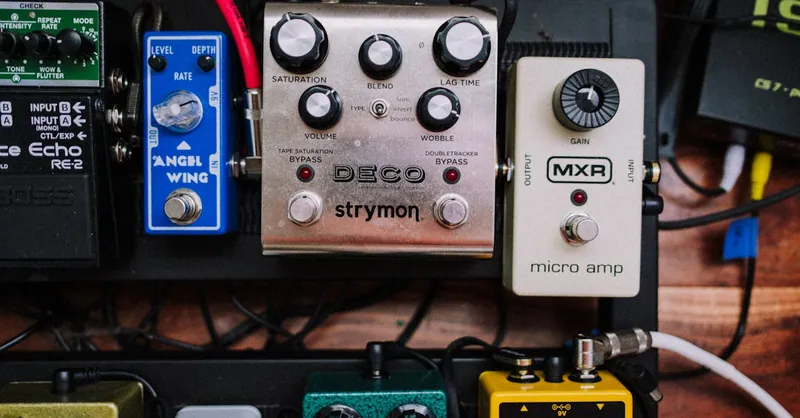
Image courtesy of Kelly
